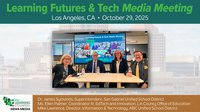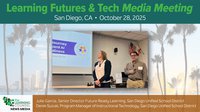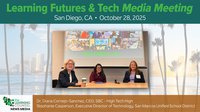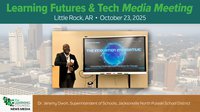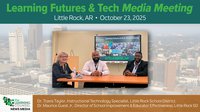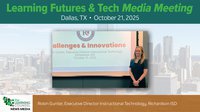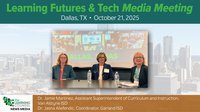There are several divergent points of thinking when it comes to considering adoption of a Matrix Digital Model of teaching and learning. Becoming organized and more efficient digitally involves a recasting of many of the methods and procedures of traditional schooling.
These are the essential ones
Distinguish Analog vs. Digital
Every point of the GVC needs a clear distinction between teaching content via human discourse or interaction, and self-directed learning or information input such as reading text, watching a video, or completing a module in courseware. For example, a course may say “in Step 1. Do the third module in JoyLearning, Step 2. Small group discussion with teacher.” This distinction allows for the separation of time/space togetherness flexibility needed for a Hybrid Logistics Platform to get a school to a fully realized Matrix Digital Model that allows personalization of learning and pace. This is really no different than lesson planning which assigns homework separately from in-class lecturing and discussion. It just zeroes in on exactly what is done by a human teacher to teach that is not the study materials or the distribution of those, but the thing done in moments of togetherness that elevates the separate autonomous journey.
Build with foreknowledge of randomized entrance points to the curriculum map
This means students could be at any point based on a pre-assessment and start from there at any time. Courses themselves can start and end at any time for any student.
Build with Pace Timing
All materials should have notations of time for a median of pace. Students may be slower or faster than other students, but time notations can alert teachers and administrators to intervene if they are built in. This is an
important point if whole groups are to be disaggregated into individual learning paths.
Build with Anticipated Future Complexity
A Guaranteed and Viable Curriculum (GVC) isn’t the end in a Matrix Digital Model. A highly varied crisscrossing of
alternative paths for students for skill increase, remediation, and interest, overlay mapped to the main viable curriculum is possible. It is the vision of a matrix.
These alternative paths would use automations based on student behaviors like time-on task, formative or summative assessment results, and other indicators just like the recommendations engines in online shopping. Custom interjections of alternative/ additive materials by teachers would be based on searching words related to the learning problem observed and simply checking presented resource bundles to be spun into the playlist of that student. Teacher skills would further add to this crisscrossing of options over time, customizing as needed.
Build for Teaching Teams
Courses do not have to be single-teacher assigned in a well-orchestrated model but can be assigned to teams such that a teacher of-record who has a temporarily overwhelmed calendar can have settings to automatically defer the next student meeting to a team member.
Build with a Membership Economy in Mind
Choice in learning is now a given. Create appeals for student membership in your school’s community with as a whole body of options and expert customization on-the-fly.
Reward Proficiency and Progress
As pace-based learning experiences are designed to engage students according to their needs and interests, students navigating a personalized learning path will progress and show proficiency in a range of modes. Rewarding progress and proficiency with badging and leveling up, as seen used in many top-tier digital resources, both acknowledges effort and builds intrinsic motivation.
Rethink Space and Where Learning Takes Place
Restructure learning spaces toward autonomous and synchronous learning. Consider students’ physical
presence on campus as optional and flexible according to their personalized learning plan (PLP).
Redefine Teaching
The teaching moment is in flux, but not the expertise. Help teachers work through the role-shift to see the benefits to themselves and students.
Engage Partners
Many EdTech companies and consultants help with these points of an education institution’s journey. Learning Counsel Innovation Services provides direct guidance and involves other companies who have specialized expertise.
About the author

LeiLani Cauthen is the CEO and Publisher of The Learning Counsel. She is well versed in the digital content universe, software development, the adoption process, school coverage models, and helping define this century’s real change to teaching and learning. She is an author and media personality with twenty years of research, news media publishing and market leadership in the high tech, education and government industries.
Sources
Learning Counsel Digital Transition Administrator and Teacher Surveys 2021, 2022
https://finance.yahoo.com/news/private-tutoring-market-us-grow-030000124.html?fr=yhssrp_
catchall
https://www.fortunebusinessinsights.com/private-tutoring-market-104753
https://www.marketwatch.com/press-release/tutoring-market-growth-prospects-2022-demandanalysis-
price-trends-size-and-share-research-by-developments-and-opportunities-forecastto-
2029-2022-08-17
https://www.prnewswire.com/news-releases/mathnasium-named-an-entrepreneur-2021-fastestgrowing-
franchise-301248732.html
https://pjmedia.com/culture/marktapscott/2021/12/30/millions-of-americans-are-getting-freshstarts-
in-red-states-n1545459
https://generationalpha.com/; https://bestlifeonline.com/generation-alpha-facts




